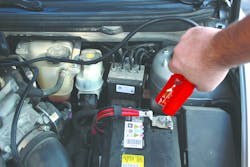As automotive batteries and related technologies advance, the tools required to service those batteries must evolve and improve as well. So, in order to properly diagnose electrical issues, investing in new battery charging equipment is critical for today’s technicians.
“Because many vehicle systems now utilize electronic controls, it is important to maintain battery voltage while servicing those systems,” says Jim O’Hara, marketing professional at Clore Automotive. “A high performance battery charger will ensure proper system voltage throughout the service to eliminate issues related to battery discharge.”
Additionally, testing the battery in every vehicle that comes in for repair is an important revenue source for shops – especially during periods of extreme heat or cold, when batteries are most vulnerable.
Lance Losinski, platform manager of chargers and networking at Midtronics, explains charging a battery during a service visit is as important as checking and topping off fluids because, as the main component in a vehicle’s power system, the battery not only enables the vehicle to start, but powers accessory controls and onboard computer systems as well.
“Chargers are important shop tools because batteries need to be maintained, using a clean, reliable power source, during vehicle service. This practice ensures that the battery isn’t depleted during service and sustains constant voltage during certain diagnostic procedures, such as an ECU reflash, to safeguard the vehicle’s electronic settings,” Losinski says.
According to Gary Mackey, vice president of global sales and marketing at Associated Equipment, up-to-date battery charging equipment provides technicians with the ability to service the variety of batteries in use. It is estimated that 55 million cars and light trucks on the road in North America alone, operate with AGM batteries, a relatively new battery technology.
“Unlike in the old days when almost all batteries had the same composition, today’s technician is faced with charging a number of different battery types such as flooded acid, maintenance-free, AGM, lithium-ion or enhanced flooded. Each of these different battery types requires different charging voltages and algorithms due to their design and chemistry,” Mackey says. “The number of vehicles with specialty batteries is growing exponentially, estimated at a rate of over 10 million per year.”
Conventional chargers, even if automatic, can damage new batteries in as little as one hour because many output charging voltages require between 15V and 18V to get the battery to take a charge.
“AGM batteries should not be charged at any higher than 14.8V, and using a conventional charger could create latent defects or destroy the battery altogether. Today’s technician needs a battery charger that works on all battery types, especially if there are selectable rates or types,” Mackey says.
Major reasons for premature battery failure include sulfate buildup on battery plates; battery self-discharge; key-off parasitic drain; insufficient run-time; corroded battery terminals and cables; intermixing of unmatched batteries; operator error; faulty electrical systems; and physical damage.
“Through a properly implemented battery maintenance program (BMP), technicians can reverse and prevent premature battery failure,” says Zena Johnson, marketing manager at PulseTech. “Preventive maintenance allows technicians to extend battery life, eliminating the need to consistently purchase new batteries, resulting in dramatic savings to the bottom line. It also improves the technicians’ productivity so they are free to perform other mechanical work like troubleshooting and repairs.”
Benefits of a BMP include recovery of spent batteries thought to be dead and useless; reducing hazardous waste and extending the use of existing materials; and keeping batteries in storage fully charged, among others.
Important specs to consider
To get the most production out of charging equipment, Clore’s O’Hara says, “The charger should utilize an automatic, multi-stage charging sequence, which will provide a better charge to all battery types serviced. It is also helpful if the charger features the ability to recondition sulfated batteries.”
Additionally, shops may consider their needs in terms of mobility. If a tech needs to charge batteries away from the service bay, a charger on wheels that is rated for outdoor use may be needed. Safety features of a charger should be addressed as well. Does the charger offer spark-free operation with reverse polarity protection, battery fault detection or over-/under-voltage protection?
Newer smart chargers are polarity-indicated and protected. According to Associated Equipment’s Mackey, many perform deep discharge recovery of sulfated batteries and battery diagnostics or testing of the battery during the charging process. “The new chargers are microprocessor-controlled and set the charge rate and duration of the charge automatically,” Mackey says.
“Clean power supplies are a bonus you pick up in many of the new smart chargers,” he adds. “The same is true of a memory saver. Some smart chargers have them built in as a feature giving the technician the functionality of three separate pieces of equipment in one; an all-type battery charger, a power supply and a memory saver.”
It is important for the shop and technician to look for a charger that meets the full range of their shop’s needs. Equipment purchasers should consider future battery technology as well when deciding if a battery charger will continue to meet a shop’s needs.
Johnson of PulseTech says the chargers’ ability to remove lead sulfate buildup on the battery plates is important too.
Additionally, some three-stage, smart chargers not only feature LEDs to indicate the battery’s state of charge, but also are capable of switching from a bulk charge - the initial charging stage when the highest voltage and amperage is used - to a float maintenance charge - the third stage where the voltage tapers down to safely bring the battery to a 100-percent charge.
“Plug-and-play smart chargers will not turn on unless connected properly and will not arc,” Johnson says in regard to the latest safety features. “Also, look for a charger that is capable of equalizing the cells within a single battery with all batteries in a parallel battery bank.”
Moreover, the battery charging product category is beginning to revolve around the “connected shop” in which wireless capabilities are integrated to connect chargers to other tools and equipment, as well as the cloud, to create a seamless shop system, according to Midtronic’s Losinski.
“Connected equipment allows technicians to easily share information between tools, maintain detailed vehicle service records and keep equipment up to date with the latest software and algorithms as new battery chemistries and technologies emerge,” he says.
Identifying a customer’s need
Midtronics’ Losinski says there are a number of questions distributors can ask to gauge a customer’s need for battery charging products. Do your customers routinely perform vehicle services that take more than 20 minutes? Do they perform reflash or diagnostic procedures that require power to a vehicle? If batteries come into their shop with a low state of charge (SOC), do they have to charge them and then re-test before receiving a definitive state of health (SOH) decision? Do they need quick decisions on batteries that are deeply discharged? Do they work with group 8D size batteries and need to get these batteries in service quickly?
Distributors should focus on features, quality, performance, application coverage and SKU management when considering and selling battery charging products, Clore’s O’Hara says.
“A simple question to ask is, ‘What type of charger are you using now?’ If the answer is that the shop or tech is using an old-school, volts–go-up and amps-go-down charger, it is time for a new one. Period,” he explains. “That charger cannot be used on AGM, spiral wound and gel cell batteries, just to name a few.
“Secondly, it is getting close to the point where almost every hood-up event should involve the connection of a battery charger to the vehicle,” explains O’Hara. “In this circumstance, each bay will require a dedicated charger. In most shops, this is not currently the case, presenting another great selling opportunity.”
Associated Equipment’s Mackey says it is possible that service providers are unaware that they are servicing AGM batteries, even though they have been available in some specialty vehicles since 1999. Educating customers about new technology batteries could produce sales. He says to ask if the shop has a clean power supply for extended service procedures, or if there is memory saver capabilities in the shop?
“If a customer is working on a newer vehicle and performing drivability diagnostics, the distributor should focus on selling that customer a smart charger,” he says. “Use of a smart charger will also help lower the warranty exposure of shops damaging batteries by charging them with older technology charging equipment.”


